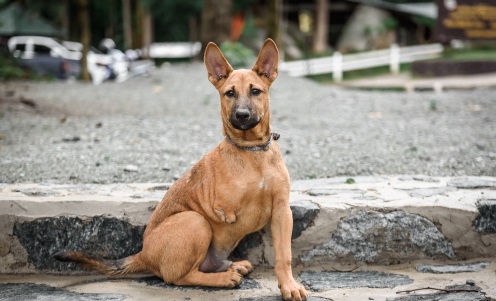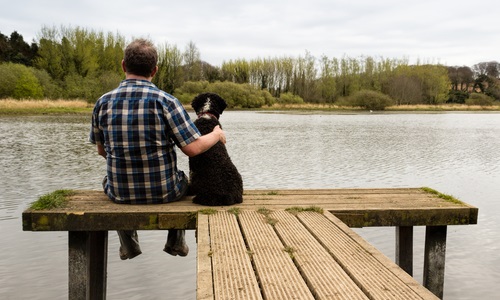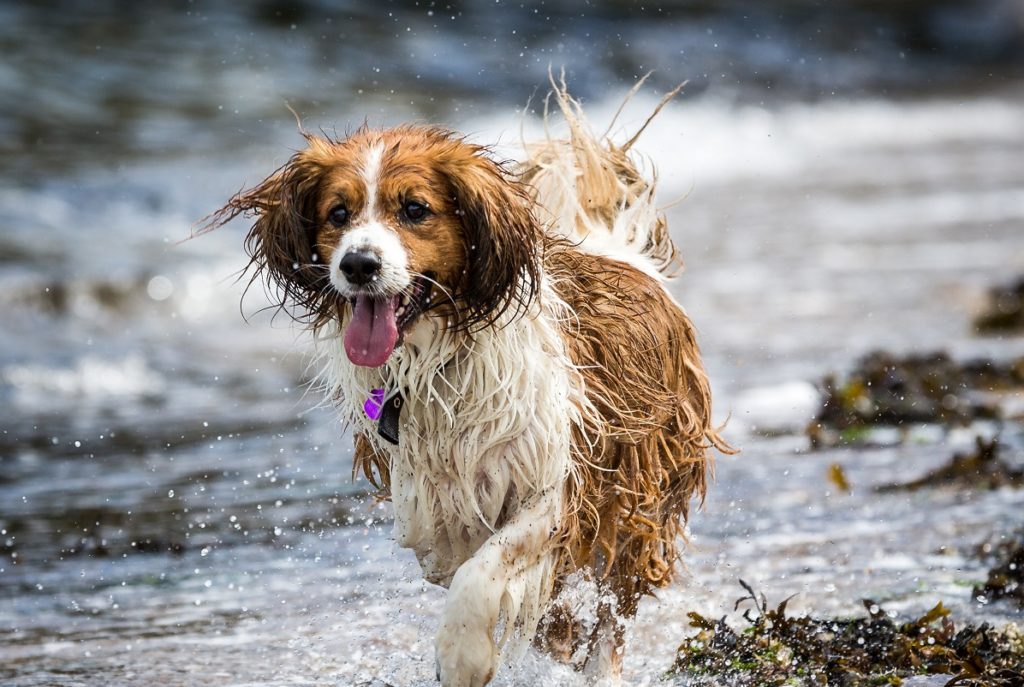Have you fallen in love with a three-legged dog that you are hoping to adopt? Handicapped animals are resilient and loving dogs that have the same fun-seeking and joyful personalities as their four-legged counterparts. However, it’s important to keep in mind that these pups will need a little extra care and attention.
Affectionately referred to as a tripawd among dog lovers, a three-legged dog can be an amazing addition to household. Even with one less leg, a three-legged dog can have a happy and fulfilling life with the right care and owner. Below is a complete guide on how to properly care for a three-legged dog.
An Introduction to Three-Legged Dogs
Dogs can end up handicapped from a variety of different circumstances. Whether it was a birth defect, accident, or illness, most dogs who have endured such physical limitations are able to bounce back better than ever. As an owner, it’s important to remember that just because a dog doesn’t have four legs does not mean they won’t be able to enjoy their life to the fullest. With time, exercise, and healing, a three-legged dog can live a life that is filled with all the things happy dogs love.
If you are caring for a three-legged dog, it’s important to know what role you play in his life. It is your responsibility to have the knowledge you need to provide him with the best care and environment possible. Dogs with a disability need to be well-exercised so that his joints can remain in good shape and further injury can be prevented. Depending on your living situation, you may need to make areas of your home handicap-friendly by placing ramps over stairs or creating a safe space just for your furry companion. With the right amount of love and knowledge, you will be well-equipped to provide a three-legged dog with a happy home.
Your Dog Needs an Amputation: Now What?
If your current dog needs an amputation it can be a heart-wrenching decision that can create a variety of different emotions for you. It’s important to remember that veterinarians do not recommend amputating a limb unless they believe that it is absolutely necessary. A veterinarian will be looking at your dog’s health as a whole, analyzing his ability to function on a day-to-day basis, and recommending a course of treatment that will give him the greatest chance of recovery. If that recommendation is amputation of a leg, it may come as a shock at first. If your veterinarian has recommended amputating a limb, it can be helpful to compile a list of questions to ask. How serious is your dog’s condition? What is the surgery process like and how fast can you expect them to recover? Just keep in mind that the better informed you are, the better treatment you can provide your suffering pup.
It’s important to note that an amputation does not restrict him from living a happy and healthy life; in fact, it can be an option that will allow your dog to experience the least amount of pain depending on his underlying condition. Although it may sound scary, limb amputation is a relatively safe surgery for dogs. And unlike their human counterparts, canines tend to have an easier time adjusting to their three-legged life as soon as they make a full recovery.
Caring for a Three-Legged Dog Right After Amputation
While there are a number of general tips to keep in mind when you have a three-legged dog, there are more specific guidelines you should know about if your dog has just undergone an amputation. This can be a challenging and anxious time for both you and your furry companion, but with care and patience, you’ll be able to bring comfort and balance to your dog in need.
 If your dog has just undergone a limb amputation, it’s vital to follow all instructions and advice that your veterinarian has provided. This will often include giving your dog antibiotics and pain medications in a certain dosage at a prescribed time interval to help keep him comfortable and prevent a canine bacterial infection at the surgery site. Even as your dog’s condition improves, always remember to consult with your veterinarian before adjusting the dose of painkillers that you are giving him. It is also required to give him the entire course of antibiotics that your vet has prescribed.
If your dog has just undergone a limb amputation, it’s vital to follow all instructions and advice that your veterinarian has provided. This will often include giving your dog antibiotics and pain medications in a certain dosage at a prescribed time interval to help keep him comfortable and prevent a canine bacterial infection at the surgery site. Even as your dog’s condition improves, always remember to consult with your veterinarian before adjusting the dose of painkillers that you are giving him. It is also required to give him the entire course of antibiotics that your vet has prescribed.
When your dog first undergoes an amputation, he will likely be confused and uncomfortable, both from the surgery and adjusting to life with one less limb. When you bring your dog home, make sure that you have comfortable and soft surfaces available for him to lay on as he is recovering. He may experience difficulty adjusting to walking on three legs at first, so it can be helpful to keep him confined to rooms with softer surfaces, such as carpeting or a rug. When your dog first comes home from his amputation, he may need your help moving around. Be sure to consult with your veterinarian about the proper way to help your dog move after surgery so that you do not cause him any pain or discomfort at the amputation site. While this time can be uncomfortable and stressful for both you and your dog, it’s important to remember that it is temporary. By relying on each other, you will be able to find a new normalcy for your routine.
Finding a Forever Family: Adopting a Three-Legged Dog
Adoption is another common situation where you will have to care for a three-legged dog. If you are adopting a three-legged dog, he has already endured his amputation and adjusted to life with one less limb or was born with a congenital condition.
Choosing to bring a dog into your life is a big decision that requires significant commitment and consideration. If you are thinking about adopting a three-legged dog from a shelter, the workers at the clinic should be able to provide you with additional information about his mobility, habits, and whether or not there are any specific needs you should be aware of.
Introducing an Adopted Three-Legged Dog to His New Home
If you do take the plunge and add a three-legged dog to your family, it’s important that you allow him time to adjust to his new surroundings. He has likely become accustomed to his prior environment, so give him plenty of time and space to adjust to his new home. For example, the dog you are adopting may have never had to climb stairs before or been allowed to get up in a chair to relax. To help him navigate these new challenges and environmental changes, you will have to work with your three-legged dog to train him to tackle new hurdles. Depending on the disposition of your dog, he may be hesitant to immerse himself in circumstances that he is not comfortable navigating. As his owner, it’s your job to help him build his confidence in navigating his new space. Rely on positive reinforcement training and maintain your patience during the adjustment period.
The Basics on Caring For a Three-Legged Dog
Just as important as it is to care for the challenges your three-legged dog faces through amputation or the adjustment after being rescued, there are also specific health considerations to keep in mind for three-legged dogs as well. These are lifetime considerations that you will need to actively monitor and integrate into your lifestyle in order to keep your three-legged dog happy, healthy, and thriving.
Maintain a Healthy Weight
Weight management is vital for all dogs to maintain optimal health, but to an even greater extent for tripawds. Because three-legged dogs are missing one limb, their weight distribution is different than four-legged companions. This means that when a dog is overweight, there is additional strain and pressure placed on his joints, which are already compromised. A healthy weight is important to maintain joint health, which will keep your dog more comfortable and mobile throughout his lifetime. In addition, when a dog possesses extra body fat, it can cause canine inflammation in his body, which can be risky for three-legged dogs. To keep your tripawd healthy, keep him on the leaner side and maintain a healthy weight to reduce strain and stress within his body.
Promote Joint Health
Joint health is extremely important for three-legged dogs because the onset of canine osteoarthritis or other joint diseases can significantly affect their mobility. If you are worried about your dog’s joints, it is highly advised to talk to your veterinarian for further treatment options and recommendations for preventative measures.
Get Adequate Exercise
A common misconception about three-legged dogs is that they will not be able to exercise, however this is not the case. Tripawds are capable of exercising and actually need adequate exercise in order to stay happy and healthy. It’s vital for a three-legged dog to maintain controlled muscle tone as his muscles allow him to offset the extra strain that is placed on his joints and other limbs due to his missing fourth leg. Swimming can be a great option for three-legged dogs since it does not place extra strain on their joints.
 Keep in mind that a three-legged dog will become fatigued more quickly than a dog with four legs, so make sure that there is time built into his exercise for water and rest. As you and your dog bond, you will be able to recognize signs that he is becoming tired and needs a break. Depending on the mobility of your dog, there are also tripod dog accessories that can be utilized to help facilitate exercise, which can be helpful for older furry companions.
Keep in mind that a three-legged dog will become fatigued more quickly than a dog with four legs, so make sure that there is time built into his exercise for water and rest. As you and your dog bond, you will be able to recognize signs that he is becoming tired and needs a break. Depending on the mobility of your dog, there are also tripod dog accessories that can be utilized to help facilitate exercise, which can be helpful for older furry companions.
Explore Modifications and Gear to Help
In addition to the tips above, there is also an entire market available with modifications and gear designed to help tripawds thrive. While many three-legged dogs have no trouble in their day-to-day life, some accessories can help improve their mobility and make it easier for them to navigate their environment. For example, there are booties and non-slip dog socks that can help to increase your tripawd’s traction to prevent slips.
With patience and proper care, you and your three-legged dog can lead a happy and fulfilling life together!
Sources:
Mueller, L. (2019, June 21). How to Care for a Three-Legged Dog. Retrieved from https://www.thesprucepets.com/three-legged-dogs-4177794
Butler, M. B. (2017, September 11). How to Care for a Three-Legged Dog. Retrieved from https://www.dogster.com/dog-health-care/how-to-care-for-a-three-legged-dog
Caring for Three-Legged Dogs and Cats, aka “Tripawds”Caring for Three-Legged Dogs and Cats, aka “Tripawds”. (2019, June 13). Retrieved from https://www.petmd.com/dog/general-health/caring-three-legged-dogs-and-cats-aka-tripawds
Keeping Your Three-Legged Dog Healthy. (2017, November 03). Retrieved from https://thebark.com/content/keeping-your-three-legged-dog-healthy




